Demand for Video Surveillance Solutions to Grow Tremendously Worldwide
05 Apr 2019 • by Natalie Aster
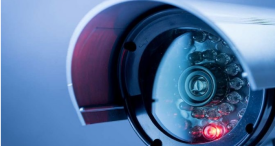
Over the past ten years, the video surveillance sector has been in a time of transition encouraged by the soaring penetration of surveillance cameras across a broad variety of applications areas, be it commercial or industrial ones.
The market is projected to keep on following an upward trajectory in the years ahead. The upturn of the video surveillance market continues to be propelled by the introduction of novel IP-based digital systems (these can enable continuous camera monitoring and ensure excellent quality output) for the detection and prevention of unfavourable behaviours like theft offences, shopbreaking, terror incidents, and vandalism. Furthermore, the mounting demand to boost safety and security, especially across critical infrastructure; soaring urban population; consumers’ inclination towards DIY and hidden cameras are adding to the sector’s growth. Also, the need for most advanced time-efficient surveillance systems at an economic cost presents one of the burning matters to be envisaged in today’s scenario. The surging popularity of video surveillance-as-a-service (VSaaS) is also fueling the world’s video surveillance system market.
In value terms, the world’s video surveillance industry is slated to increase from over USD 36 billion in the past year to exceed USD 62.6 billion by end-2023.
World video surveillance market value in 2016-2018 and 2023* (in USD billion)
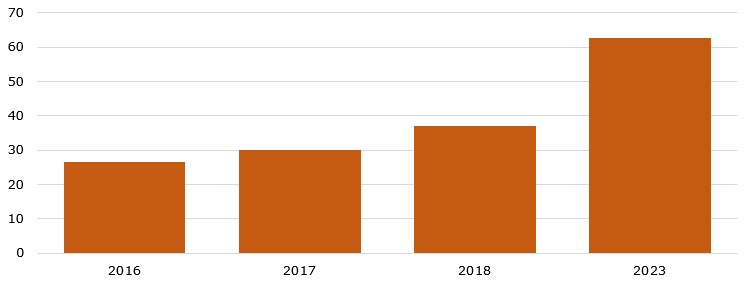
High Initial Costs and Lack of Respective Regulations Act as Key Restraints to Market Growth
Meanwhile, insufficient standardisation and the dearth of data surveillance regulations keep on being a thorn in the video surveillance market’s side. For instance, the surging trend for IP-based video surveillance systems will necessitate space-saving storage solutions. Furthermore, with the world becoming increasingly networked, the integrity of the data recorded could be put in jeopardy. Moreover, the unprepared security personnel are not briefed on the concepts of networking and associated aspects. This leads to the shortage of skilled experts to regulate the operation as well as different software issues in IP-based surveillance systems. High initial and maintenance costs also present a major force limiting the sector’s growth.
The rise in VCA and VSaaS, the incorporation of AI in video surveillance systems, the mushrooming demand for smart transportation systems, and also the integration between surveillance and new digital technologies, like drones and body cameras, have been major opportunities for potential market participants. Further, decreased pricing of cloud storage solutions has also boded well for players active in the video surveillance services domain.
Cameras Grab Bulk Share of Video Surveillance Market
In the year 2016, the revenue received from the camera segment amounted to over half of the world video surveillance market revenue, reaching USD 13.65 billion. The total cost of installation depends largely on the geographical area of surveillance, and also equipment (video cameras, monitors, storage media, etc.). Owing to the soaring volume of cameras in use there has been an increased need for VCA and VMS, which has led to the upswing of the overall video surveillance industry.
World video surveillance market share (%) in 2016, by ecosystem 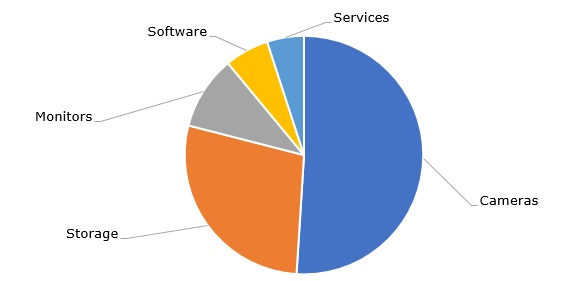
Analog Video Surveillance Solutions Maintain Dominance in Marketplace
In 2018, the size of the world video surveillance market for IP-based technology was estimated at USD 19.5 billion and is set to grow to the value of USD 22.3 billion by end-2019. Meantime, in the course of the analogous period, the value of the market for non-IP based technology is poised to increase from USD 27.8 billion to USD 30.4 billion.
World video surveillance market size from 2009 to 2019, by technology (in USD billion)
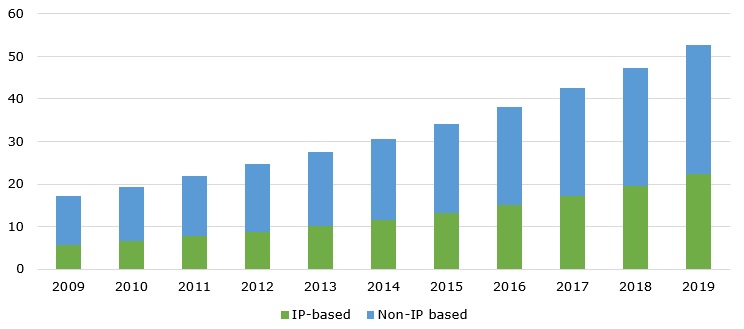
VCA Software Boasts Biggest Market Share
By software, video content analytics have turned to be a key category of the video surveillance market during the last several years, fueled by the high uptake among corporate, state bodies, SMEs, etc. The sector is still in its nascency and hence is currently applied primarily for surveillance purposes, however, visual communication and entertainment applications have begun seeing growth recently. Analytics has allowed end-users to make use of given data insights into valuable information for different functions. The insights can be utilised to create heat load maps, for monitoring queues in retail shops and hospitals, etc. Besides, the analytic programs support IP, analog, and high-resolution cameras; they also can be incorporated within the hardware elements and hence lessens the need for additional hardware, thus contributing to the reduction of implementation costs.
APAC to Maintain Leading Position in Video Surveillance Marketplace
Geographically, Asia-Pacific, led by China, is the most rapidly-evolving market for video surveillance systems and services, with the growth expected to continue in the same vein in the short run. Rapid population growth, establishment of IT behemoths, increased adoption of security cameras and soaring threat issues are amid key growth drivers. Additionally, the regional market owes its expansion to the extensive deployment of IP camera video surveillance equipment, and also massive investments in the future infrastructure projects. Country-wise, China’s market recorded and will likely continue to see the fastest growth in 2019, although its CAGR has fallen by 4,7% as against the 2009-2014 period.
The 2009-2014 CAGR of the North American video surveillance market was appr. 7.5%, whilst during 2014-2019 it stands at only 3,3%. Yet, the region grabs the lion’s share in IP-based video surveillance market owing to the presence of top players in the region along with the uptake of respective solutions by enterprises. Also, the intense competition amongst IP camera vendors, greater security concerns and increasing disposable incomes are propelling the market growth.
The CAGR of the EMEA market increased by 3,2% from the 2009-2014 period to the 2014-2019 period. The South American market growth has also seen a slight increase from the past 6-year period.
World video surveillance market growth over 2009-2014 and over 2014-2019, by region (CAGR%)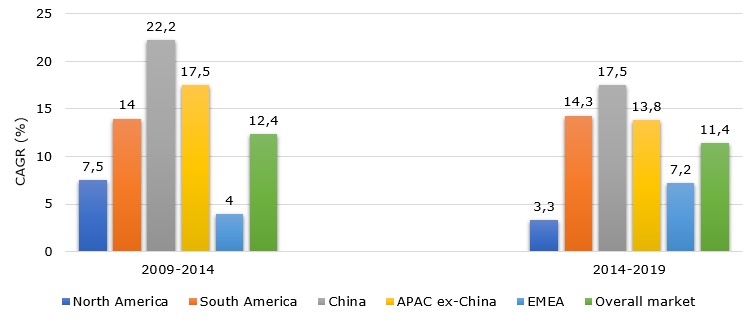
VIDEO SURVEILLANCE MARKET HIGHLIGHTS
The world video surveillance market is seeing faster growth compared to that calculated a while back, which leads to questions about where the extra growth comes from. Here are some of the major trends encouraging growth in this market:
- Rise of AI Video Analytics
Firstly, AI video analytics is №1 game changer over the next decade in the video surveillance universe, and this could considerably add to the total market value. This technology is impacting the growth of the majority of products that constitute this business. Strategic alliances with novel software developers offer further opportunities.
- Deep Learning Surveillance – the New Chapter of Video Analytics
Over the past year, there were a host of start-ups heralding a new era of video analytics. The entrenched video surveillance firms naturally view AI and deep learning as a technique to run off their current products providing a tool to differentiate themselves and add more value to their goods.
Cameras with embedded video analytics engines (face, object and motion recognition), analyse image data at the period of collection, and, in so doing, it will not be necessary to enable the transmission of data to a remote central server. And this contributes to very effective usage of transmission and recording bandwidth alike. Utilising analytics, certain cameras can also be mounted to record videos at a lower frame repetition rate and/or resolution, and then automatically boost these parameters to capture better-quality video when necessary. Nevertheless, nowadays AI software at the high end is poised to run from cloud storage.
CONCLUSION
Over recent years, there has not been a big change in the factors fueling the demand for video surveillance systems, amid them: an ever-growing urgency for monitoring security and safety, and fighting and preventing terrorist attacks within buildings and public spaces. Yet, ultimate users have taken greater interest in making video work with the commercial enterprise to boost productivity and add extra value to systems.
With IP cameras they have managed to decrease the cost of ownership (TCO) and rationalise the cost of extra features. At the company level, end users are now focused steadily on TCO metrics alongside scalability, which can be attained through IP only.
The near future is poised to turn into an exciting and turbulent time for the video surveillance field with AI video analytics and IoT slated to impact it considerably. And it is important for manufacturers of video surveillance products to know the needs of the customers, how to apply AI video analytics as well as elaborate the supply chain.
© MarketPublishers.com, 2019
Analytics & News
